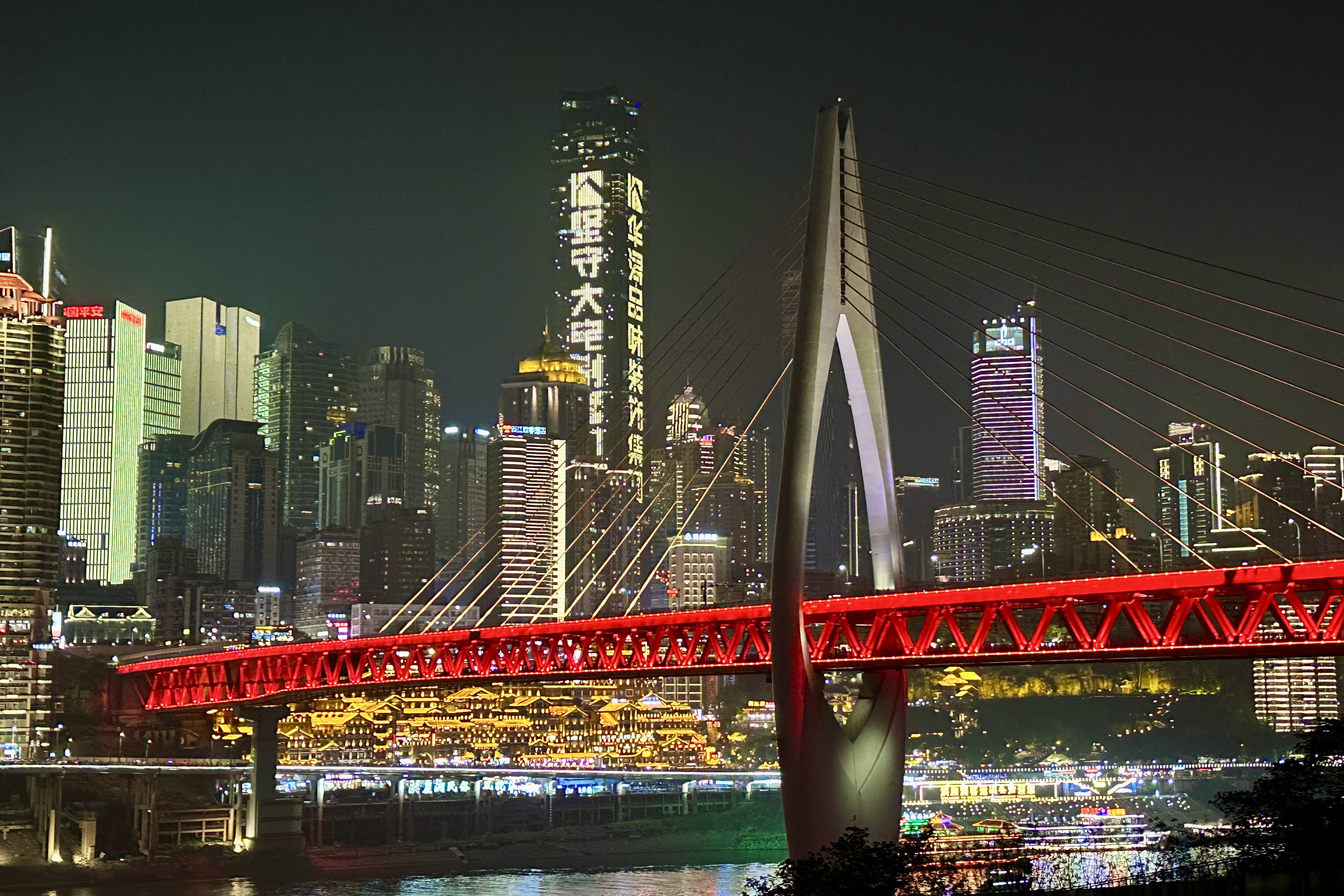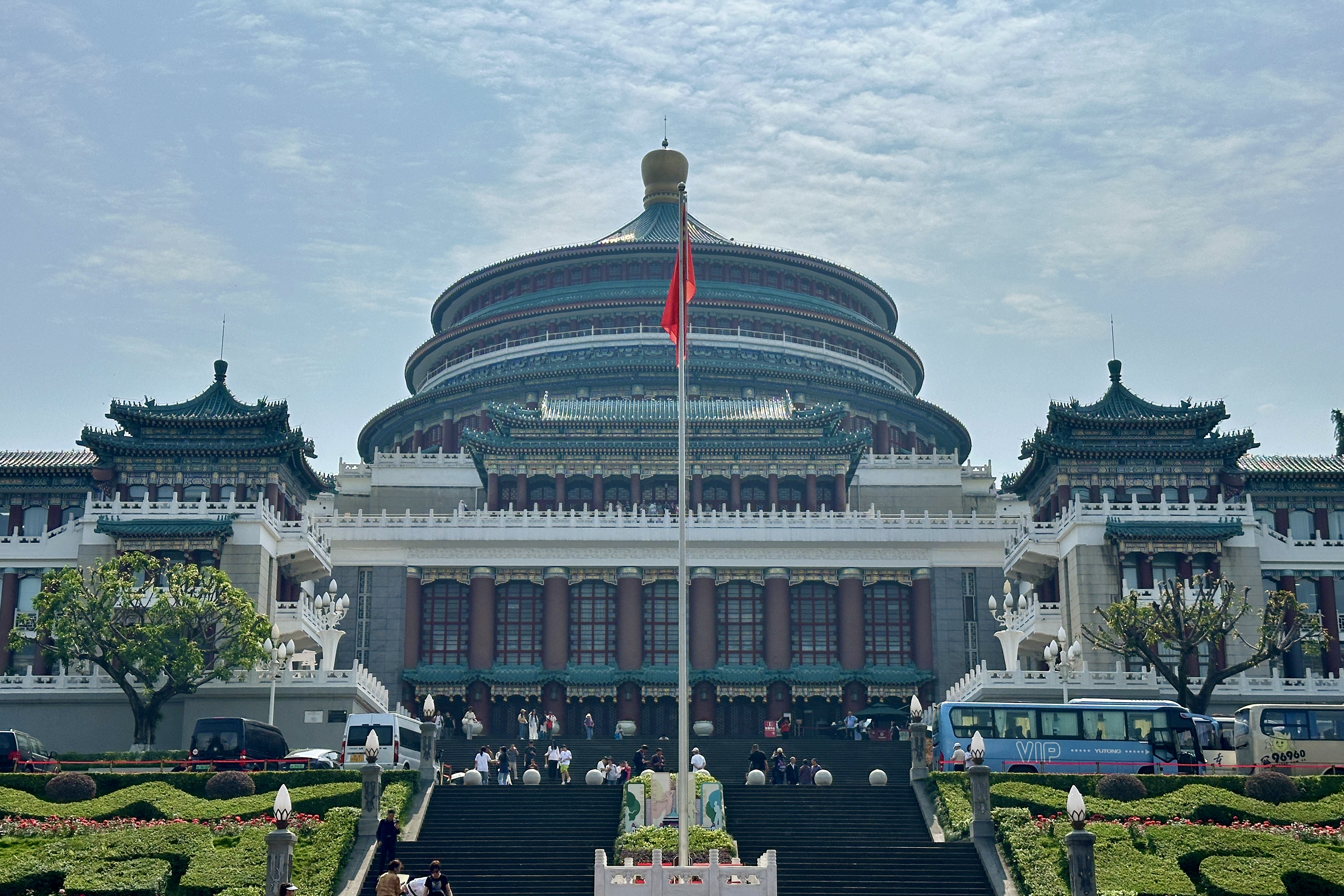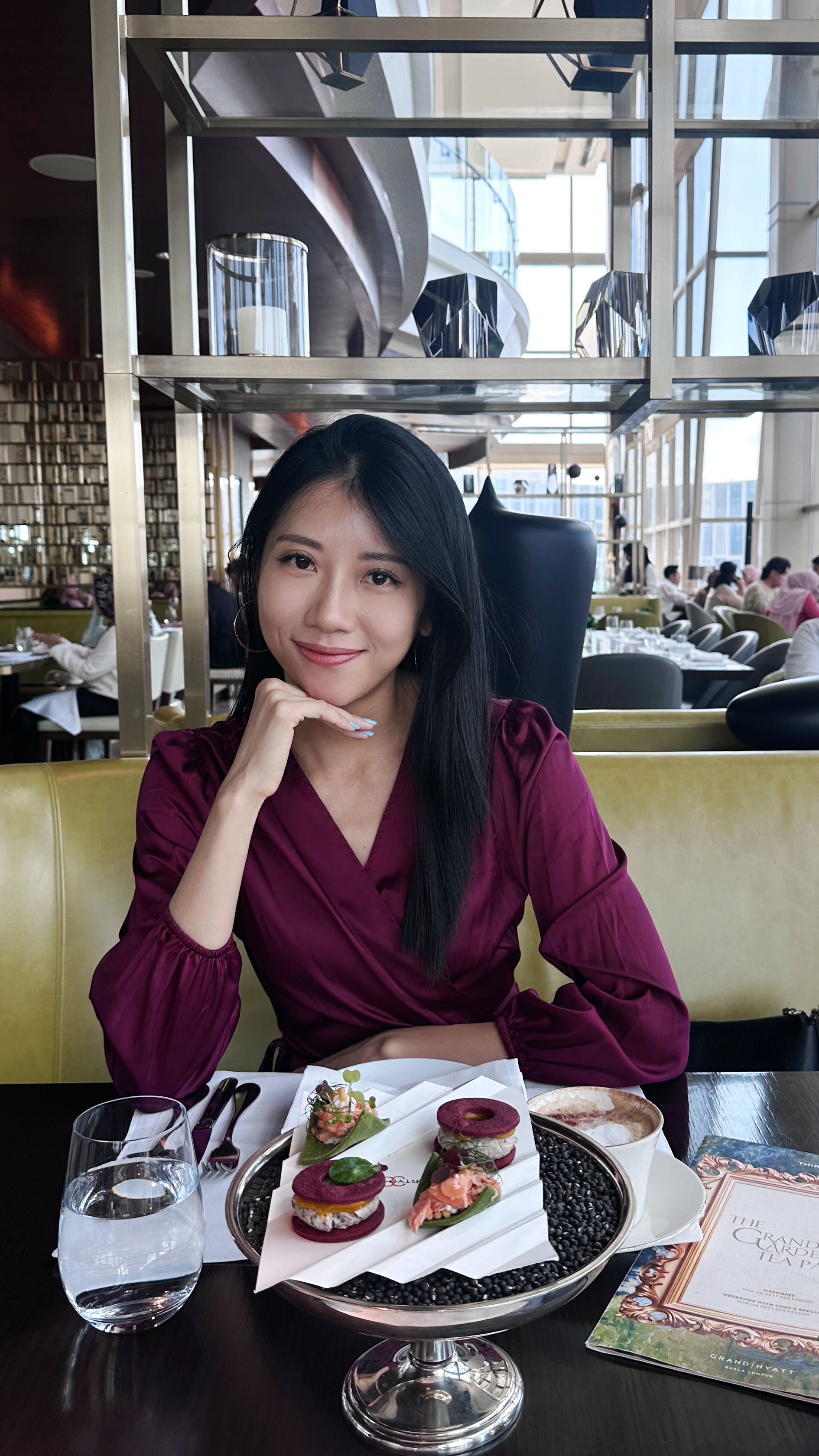
Curator’s statement
Chongqing captivated me with its dramatic landscape, layered history and unapologetic intensity. Perched between rivers and mountains, the city pulses with a rugged charm that’s both overwhelming and exhilarating, from misty stairways and hidden alleyways to fiery cuisine that lingers on your lips and in your memory. What made it truly special to me was how it balanced the weight of the past with the speed of modern life, all while keeping its soul intact. It’s a city that doesn’t try to please you, yet somehow, you fall for it anyway.
The Fora Difference
Book with Jocelyn to access exclusive perks and experiences on your trip.
Killer perks
Free upgrades, spa credits and more—we got you
Personalized recs
Customized travel planning for your style
Insider knowledge
Expert advice from people who’ve actually been there
Where to stay
Unlock perks by contacting Jocelyn to book your trip.
Day 1: First impressions of Chongqing — Where mountains meet megacity

View from Jiangbeizui River Beach Park
Afternoon – Arrival & Street Noodles: A Flavorful Welcome in the Mountain City
We arrived in Chongqing from Chengdu by private car, a scenic 4-hour journey that curved through lush hills and river valleys. After checking into our hotel, we wandered through the surrounding streets and stumbled upon a small local noodle shop: A Fu Ban Deng Noodles (阿福板凳面). It wasn’t on our radar, but the long line outside was a promising sign — and it did not disappoint.
We ordered three classic local dishes:
Zhajiang Noodles (炸酱面) – Thick, chewy noodles smothered in a rich soybean and ground pork sauce, topped with refreshing cucumber strips. This was my favorite: deeply savory and perfectly textured.
Spicy Red Oil Wontons (红油抄手) – Soft wontons bathed in a bold, chili-oil sauce with hints of vinegar and numbing Sichuan peppercorns.
Hot and Sour Noodles (酸辣粉) – A fiery, tangy mix of sweet potato noodles that clung to the sharp broth, delivering a true kick for spice lovers.
Afternoon – Mountain City Trail: Descending Through Time and Topography
Next, we made our way to the Mountain City Trail (山城步道), one of Chongqing’s most iconic urban walking experiences. Instead of hiking up, we took a Didi to the upper entrance at Embassy Alley (领事巷) and began our descent from there.
Before starting the walk, we stopped at Yuantong Gate Park (远通门)—a historic city gate once part of Chongqing’s ancient fortifications. A series of wartime statues here evoke the city’s role in resisting Mongol cavalry and several other premodern attacks.
The trail winds through older residential neighborhoods built into the hillside, with narrow staircases, quiet courtyards and scattered lookout points revealing striking urban panoramas. It’s a contemplative walk that contrasts beautifully with the dense chaos of modern Chongqing.
One of the highlights was a panoramic lookout with sweeping views of the Yangtze River and the city skyline — an incredible spot for photos.
Late Afternoon – Eighteen Stairs: Layers of History and Urban Texture
We continued walking to the Eighteen Stairs (十八梯) area, a historic neighborhood that’s been modernized but still carries the spirit of old Chongqing. The steep ramps and preserved stilt houses capture the mountain city's vertical rhythm. Though now lined with shops and cafés, the area includes the Eighteen Stairs Mountain City Memory Museum (十八梯记忆博物馆), a small exhibit space showcasing the area’s evolution.
Along the way, we made some enjoyable stops:
Ren’ai Church (仁爱堂) – A serene church tucked between hills and high-rises.
Old-Style Sesame Flatbread (老烧饼) – A tasty, flaky street snack with a rich aroma.
Woozone Rooftop Café (瓦座) – A trendy café perched with an unbeatable view of Nanjimen Rail Bridge (南纪门轨道大桥). We had some drinks here, relaxed, and took some of our best photos of the day.
Dinner – Fanbatuo: Local Dishes With Heart and Heat
For dinner, we went to Fanbatuo (饭粑跎), a cozy restaurant specializing in Chongqing home-style dishes. The atmosphere was relaxed — just locals sharing generous plates of comforting food. Our favorites include:
Shredded Potato Salad (拌土豆丝) – Light, vinegary and crunchy.
Douhua (豆花) – A savory version of soft tofu, served warm and silky in a spicy sauce.
Sliced Pork in Garlic Sauce (拌白肉) – Tender pork drenched in raw garlic and chili oil — a bold and addictive dish.
Evening – Night Views From the Riverside: A Quiet Moment of Awe
Instead of heading to the always-crowded Hongyadong (洪崖洞), we strolled through Jiefangbei Pedestrian Street (解放碑步行街) and continued to Jiangbeizui River Beach Park (江北嘴江滩公园) near the Chongqing Grand Theatre (重庆大剧院). This less-touristy spot gave us front-row views of the illuminated city skyline.
From here, we admired:
Hongyadong, glowing like a stack of lanterns along the cliffside.
Chongqing Raffles (重庆来福士), resembling a ship cutting through the high-rise jungle.
The river bridges lit up in brilliant color, their reflections glimmering on the water.
Pro Tip: Skip the tourist masses at Hongyadong’s viewing platforms and come to Jiangbeizui River Beach Park instead. It’s peaceful, photogenic, and offers better angles for skyline photography.
Day 2: Culture, creative spaces & culinary surprises

Chongqing Great Hall of the People
Morning – Great Hall of the People: Grand Architecture and Echoes of History
We started our morning at the Great Hall of the People (重庆市人民大礼堂), one of the city's most iconic landmarks. Initially, we only planned to admire it from the outside — the domed architecture resembles the Temple of Heaven in Beijing and is a striking example of Sino-Soviet design fusion. But for just 8 RMB per person, we decided to explore inside.
The interior is simpler compared to its imposing exterior, but if you're a history enthusiast, you'll find value in the exhibits detailing the hall’s function as a venue for political gatherings and cultural performances since its completion in 1954. It’s often referred to as the "city’s living room"—a space where locals have long gathered for important municipal events.
Lunch – Hefu Noodle (和府捞面): Light, Comforting & Unexpectedly Delightful
For lunch, we headed to Hefu Noodle, a modern Chinese noodle chain with locations across over 60 cities. It’s not specific to Chongqing, but after days of rich local flavors, this lighter, herbal take on noodles was a welcome change. I ordered the Herbal Pork Bone Broth — the soup was incredibly fragrant and rich, with deep umami notes and a soothing aroma. The noodles were perfectly bouncy, and the ambiance was a calming contrast to the intensity of the local street food.
Afternoon – Eling Second Factory: Creative Vibes in a Repurposed Industrial Gem
After a short rest at our hotel nearby, we ventured to Testbed two Arts Center (鹅岭二厂). This spot beautifully blends Chongqing’s history with modern design, as it was once a banknote printing facility for the Central Bank of China. Now revitalized into a multi-level creative complex, it’s filled with bookstores, boutiques, indie cafes and art spaces, perfect for exploring, taking photos or simply relaxing.
We grabbed milk tea from Chagee, a very popular tea shop known for its fragrant brews and high-quality ingredients. It was a nice way to enjoy the creative energy of the space while resting our feet.
Afternoon – Liziba Station: Trains Through Buildings & Tourist Spectacle
Next stop: Liziba Station (李子坝)—one of Chongqing’s most talked-about photo ops. Famous for the monorail that passes directly through a residential building, it’s a quirky demonstration of Chongqing’s space-maximizing urban design.We joined the small crowd waiting to film the moment the train emerged from the sixth floor. It was fun to see once, but it’s more of a novelty “check-in” spot than a full experience — worth a short detour, especially if you’re nearby.
Late Afternoon – Guanyin Bridge Food Street: Night Market Buzz & Street Eats
Our next stop was Guanyin Bridge Pedestrian Street (观音桥步行街), a vibrant commercial district teeming with food stalls, fashion boutiques and lively crowds. If you’re a street food lover, this is your paradise. The scent of hot pot broth, grilled skewers, spicy noodles and sugar-glazed fruits wafts through the alleys. We indulged in:
Grilled shellfish, smoky and succulent.
Takoyaki, crispy outside with gooey octopus filling.
Taro Ball Dessert Soup – sweet and chewy, perfect to cool down after all the spice.
We also stopped by a boutique bakery called Sumine (菽麦谷屋) and tried two pastries on a whim — light, flaky and not too sweet. It was a pleasant surprise and a break from the spicy overload.
Evening – Jiefangbei: Chongqing’s Urban Heartbeat
After snacking and strolling, we headed to Jiefangbei (解放碑)—Chongqing’s most famous commercial landmark. The central monument, originally built in 1945 to commemorate the victory over Japan, now sits surrounded by a jungle of neon-lit skyscrapers, high-end shopping malls and bustling pedestrian zones.
It’s the Times Square of Chongqing — a place where locals shop, meet, eat and just soak in the city’s high-energy vibe. The nighttime lights were dazzling, and even if you’re not here to shop, it’s worth seeing the monument and taking in the dynamic atmosphere.
Dinner – Hot Pot at Mujiuge: Bold, Fiery & Family-Owned
For dinner, we decided to go big with our second hot pot of the trip at Mujiuge Old Hot Pot (木九格老火锅). This family-run hot-pot joint had a warm, rustic feel — much cozier than the big chains. We split the pot between the two broths:
Mala – Intensely spicy, oily and numbing. Note: This version was noticeably hotter than what we had in Chengdu — Chongqing doesn’t hold back on spice.
Tomato – bright, tangy and soothing — a perfect counterbalance.
We ended the night red-faced and full-bellied, but satisfied.
Pro Tip: If you're trying Chongqing-style mala hot pot for the first time, consider ordering a dual-flavor pot. The tomato or mushroom side will give your tastebuds a break from the firestorm!
Day 3: Rainy day retreats, refined flavors & a farewell stroll

The Ring Chongqing
Late Morning – The Ring (光环购物公园): Nature-Inspired Retail Therapy
With a night flight ahead and rain falling steadily all morning, we decided to take it slow and stay mostly indoors. We started the day late and made our way to The Ring, a nature-themed shopping mall in Chongqing that’s often compared to Singapore’s Jewel Changi Airport.
While not quite as awe-inspiring as Changi, the massive indoor rainforest, sky garden and waterfall features make for a pleasant escape from the weather. It’s an ideal stop on a rainy day, and there’s plenty of food, shopping and scenery to enjoy without stepping outside.
Lunch – Kao Master (烤匠): Grilled Fish Comfort on a Rainy Day
We had lunch at Kao Master, a popular chain specializing in grilled fish. Though their signature dish is Mala Grilled Fish, we decided to skip the heat for once and ordered the Garlic Grilled Fish instead. It turned out to be a great choice — milder but full of umami, with crispy skin and tender, flavorful flesh. The garlic sauce was rich without being overpowering, making it a perfect comfort meal.
Afternoon – Three Gorges Museum (三峡博物馆): Culture & Calm
Still raining, we took a Didi to the Chongqing China Three Gorges Museum (三峡博物馆), located near the People’s Great Hall. This museum offers a comprehensive look at Chongqing’s history, culture, and the monumental Three Gorges Dam project. It’s well-organized and free to enter. We spent a relaxing hour or two exploring the exhibitions. A personal highlight? Sipping coffee at the small stand inside, listening to the rain fall outside and watching people pass by — one of those tiny moments that stay with you.
Evening – Dinner at Chen Yu (尘遇.云堤): A Refined Send-Off
For our final meal in Chongqing, we chose Chen Yu, located inside the World Financial Center (重庆环球金融中心). The restaurant offered an elegant, almost Zen-like setting with cozy booths and a refined menu. Highlights from the meal included:
Grilled Eggplant in Chili Sauce (烧椒浸紫茄子) – smoky, silky and perfectly seasoned.
Herbal Chicken with Pork Tripe (药膳肚子鸡) – deeply nourishing with layers of herbal flavor.
Dry-Braised Sweet Osmanthus Fish (干烧桂花鱼) – beautifully presented and subtly sweet.
The service was warm and attentive — a lovely, peaceful experience to close our trip.
Night – Hongyadong (洪崖洞): A Rain-Soaked Farewell
With some time left before heading to the airport, we walked to Hongyadong — Chongqing’s most famous cliffside building complex. Normally packed with tourists, the rain had worked in our favor: fewer crowds, moody reflections and a photogenic mist rising from the river. We explored the winding alleys, snapped some final photos and soaked in the fairy-tale-like ambiance of the tiered lights and stilt houses. It was a perfect, atmospheric ending to our Chongqing adventure.
Pro Tip: Before leaving the World Financial Center, take the elevator to the rooftop observation deck — the tallest in Chongqing. For 118 RMB per person (as of writing), you’ll get a 360-degree panoramic view of the city skyline, the Yangtze River and beyond. It’s one of the best places in the city to appreciate Chongqing’s dramatic topography and glittering urban sprawl.
Need to know
Didi (Chinese Uber) is the easiest way to get around if you don’t speak Mandarin. It's affordable and convenient, especially in hilly terrain.
The Chongqing Metro is clean, fast and scenic — Line two (which runs above-ground at points) is especially popular for views.
Use a VPN (installed before arrival) if you need access to Google, Instagram or WhatsApp.
Very limited English is spoken, even in popular areas. Baidu Translate is your best friend.
Screenshots of Chinese names for places and dishes will make your life much easier.
Chongqing cuisine is intensely spicy and oily, even by Sichuan standards. Ask for “微辣” (wēi là — mildly spicy) or “不要辣” if needed.
Public restrooms are widely available, especially in malls and parks — but squat toilets are still common.
Mobile payment (WeChat Pay / Alipay) dominates. Many places don’t accept foreign credit cards or even cash.
Some international cards can now be linked to Alipay or WeChat Pay, but check in advance. It’s worth setting this up before you arrive.

Travel Advisor
Jocelyn Heng

Get in touch with Jocelyn
Did you like this guide? Reach out to customize and book your own experience. Or, just to chat about travel in general.
You can expect a response from Jocelyn within 1–2 business days. You’ll also be subscribed to our traveler newsletter (you can unsubscribe at any time).
For more inspiration and insider recommendations, check out our China page.